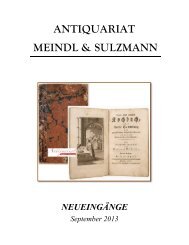Japanese Prints
Japanese Prints
Japanese Prints
You also want an ePaper? Increase the reach of your titles
YUMPU automatically turns print PDFs into web optimized ePapers that Google loves.
Henry Sotheran Limited 75<br />
Lantern<br />
<strong>Japanese</strong> lanterns are used to escort the bride at her wedding, and<br />
are now symbolic of good luck in marriage. They are also necessary<br />
at funeral processions where there must be two or more plain<br />
lanterns at the head, even when the funeral is held in day time, in<br />
order to lead the spirits because the land of the dead is dark and<br />
gloomy. This is why there are so many stone lanterns in shrines.<br />
Lily<br />
A lily is a plant that is used to help you forget your troubles. It is<br />
also known as the bringer of sons so is often given to a woman upon<br />
her marriage.<br />
Lotus<br />
The lotus is a symbol of new birth, the flower of life and one of the<br />
eight Buddhist emblems. The Buddha himself is said to have risen<br />
from the centre of a lotus blossom. Besides the religious meaning it<br />
stands for the symbol of all that is true, good, and beautiful for it<br />
rises out of the mud, yet is not contaminated.<br />
Maple<br />
The maple symbolises the brilliant colours of autumn, and in<br />
celebration of this, the <strong>Japanese</strong> hold parties under the maple leaves,<br />
as they do during the cherry blossom season. As the leaves fall, they<br />
remind us of the transience of life, and living life for the moment.<br />
It is a popular motif on Kimonos.<br />
Monkey<br />
The monkey is one of the most painted animals in <strong>Japanese</strong> art. A<br />
well-known representation is that of the ‘three mystic monkeys’:<br />
1) Kika-saru, the monkey who is covering his ears with his hands;<br />
2) Mi-saru, the monkey who is covering his eyes with his hands;<br />
3) Iwa-saru, the monkey who is covering his mouth with his hands.<br />
Hear no evil, see no evil and speak no evil. Monkeys bring the<br />
message of right living to the people.<br />
Morning Glory<br />
The asagao (morning glory) is a strong symbol in the <strong>Japanese</strong><br />
culture. Originally brought to Japan around the 10th century from<br />
china for medicinal purposes, their lovely flowers have captured<br />
the hearts of the <strong>Japanese</strong> people and have been the inspiration for<br />
many <strong>Japanese</strong> poems. The morning glory flower has become<br />
symbolic of summer in Japan and it is still one of the most popular<br />
summer garden plants.<br />
Nightingale<br />
Usually shown together with the plum blossom, it is considered the<br />
herald of spring. They also symbolise sweetness and anticipated<br />
happiness.<br />
Owl<br />
A symbol of wisdom. Its image can also be used as a talisman to<br />
keep away evil. The nihon-shoki, one of the oldest books on<br />
<strong>Japanese</strong> history and mythology, describes it as a good omen. The<br />
<strong>Japanese</strong> word for owl ‘fukuro’ is also a homophone for ‘no<br />
hardship’.<br />
Paulownia<br />
Also known as the “princess tree”, it was once customary to plant a<br />
paulownia tree when a baby girl was born, and then to make it into<br />
a dresser as a wedding present for her marriage. paulownia also<br />
serves as the emblem of the prime Minister, cabinet and the<br />
government.<br />
Peacock<br />
The creature associated with the <strong>Japanese</strong> and chinese goddesses<br />
of mercy. In the Buddhist tradition, the peacock’s ability to eat<br />
poisonous snakes can be understood as a symbol of the<br />
transmutation of evil into good. It is also considered the<br />
representation of true beauty.<br />
Peony<br />
As the flower of summer it has always been regarded as a symbol<br />
of magnificent wealth, fortune and prosperity to the extent that it is<br />
sometimes known as the ‘king of flowers’. The peony has a lush,<br />
full, and beautiful bloom suggesting luxury and opulence and has<br />
become an emblem of regal power in Japan. rich in colour and<br />
beauty, the peony was regarded as the flower of riches and honour,<br />
associated with aristocracy and prosperity. The peony is the rose<br />
without thorns, and so embodies romance and love, and is regarded<br />
as the omen of good fortune and a happy marriage as well.<br />
Phoenix<br />
The phoenix is usually seen alongside a dragon and symbolises the<br />
Empress. It is commonly used as a female symbol.<br />
Pine<br />
In Japan, the pine tree is considered one of the most beautiful trees.<br />
Several pine trees in Japan are over 800 years old. Over time the<br />
climate and other natural causes, as well as pruning and trimming,<br />
form the picturesque pine tree. It is one of the most auspicious<br />
symbols in all Japan of fortune and nobility. The pine is considered<br />
sacred, a belief that may stem from ancient Shinto ideas of trees and<br />
other plants as representations of divine spirits. In Japan, entrances<br />
to houses are often decorated with pine branches to welcome the<br />
Gods at new Year; its needle-shaped leaves are believed to have the<br />
power of driving away unwanted demons and protecting good<br />
fortune. The long-life of this tree and the fact that they are evergreen<br />
make them a symbol of strength, longevity and endurance. With the

















